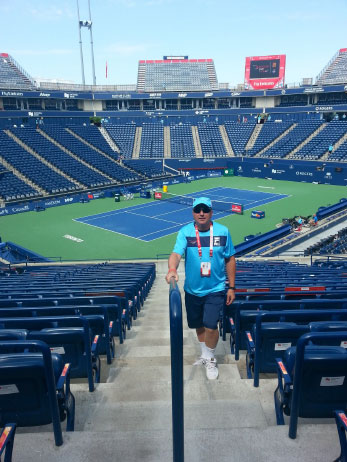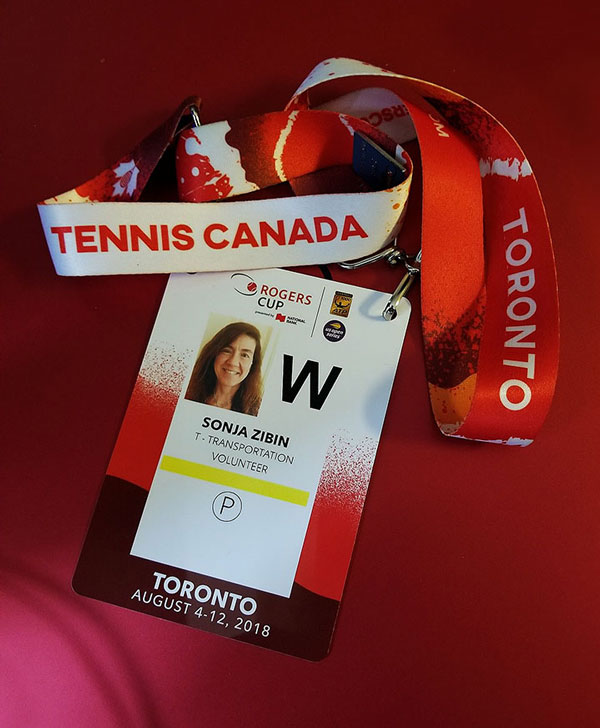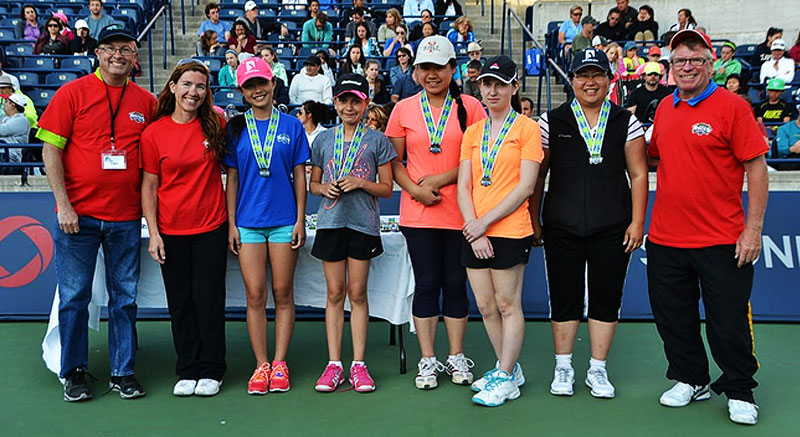Yep, they were all cogs in the wheels that drove the Rogers Cup to another year of strong attendance and to new heights in national pride in 2019. Nadal and Canada’s Andreescu were the men’s and women’s singles champions. Scarfo, 64, participated in the tournament for his fourth consecutive year as a volunteer usher, one of 2500 volunteers working at the Toronto and Montreal sites. The event couldn’t function without the volunteers, says Gavin Ziv, Managing Director, Rogers Cup.

Rogers Cup volunteer Joe Scarfo... "tickets please".
“Volunteers are one of the most critical resources in the successful staging of our event. Between the two cities, they work over 100,000 hours during the week and have over 15,000 years of experience working at the tournament. There are over 20 committees in each city that are managed, supervised and run completely with volunteers. None of these would be able to function without them,” Ziv said in a recent email.
For Scarfo, volunteering at the Rogers Cup started as a retirement activity and has grown from one week every summer at the tournament in Toronto to year-round involvement at his community tennis club. He joined as secretary on the volunteer board of directors of his local club, York Weston, in Toronto’s west end one year ago.
“Socialization is a big part of being at the Rogers Cup. I love meeting new people, keeping in touch with others from the tennis community. Plus, as an usher, I can get to watch some great tennis,” he said.
“I was volunteered into my position at York Weston,” he added with a laugh. “I have enjoyed it. There is the socialization part of it, but I have also learned a lot about how decisions are made and the costs and the challenges that community clubs face. People who have the time should consider volunteering because even a little bit can be so important.”
Community tennis clubs across the province operate under a partnership agreement with local municipalities. The municipality provides the courts in return for annual permit fees. In Toronto, for example, Tennis Toronto-member clubs adhere to the city’s Policy for Outdoor Community Tennis Club Operations that stipulates, among other subjects, that outdoor clubs are not-for-profit organizations managed by volunteers. All clubs have a board of directors including president, vice-president, secretary and treasurer as well as other positions such as social, tournament, team and maintenance chairs.
“Volunteers are key parts of many organizations, community tennis clubs among them. It can be difficult sometimes to find people willing to volunteer or who have the time with the demands of young families and careers. It seems that boards of directors are frequently older or retired members, although our new president, Wojtek Hoch, is neither old nor retired,” said Vaughan Grater, who recently stepped down after a five-year term as president, Pine Point Tennis Club, in west end Toronto. “Volunteers are the backbone of community tennis,” he added.
A recent study by Statistics Canada titled Volunteering in Canada: Challenges and opportunities during the COVID-19 pandemic confirms Grater’s thought about the role played by older or retired people. The report’s highlights include:
- Almost 12.7 million Canadians engaged in formal volunteering in 2018 with approximately 1.7 billion hours of their time given to charities, non-profit and community organizations. This is equivalent to 863,000 full-time, year-round jobs.
- Matures (40 per cent) and baby boomers (31 per cent) were more likely to be top volunteers than iGens (18 per cent). Top volunteers contribute 132 hours or more annually. The report defines matures as 73 to 100 years of age, baby boomers 53 to 72 and iGen 15 to 22.
- iGens, however, had the highest overall volunteer rate (52 per cent) and contributed an average of 82 unpaid volunteer hours.
- On average, most volunteer hours were contributed to hospitals (111 hours), religious organizations (110 hours) and sports and recreation associations (105 hours).
The Ontario Tennis Association (OTA) does not have a profile or description of volunteer demographics across the province, but there appears to be a belief that rural and smaller clubs typically rely more on older volunteers than do larger, urban clubs.
“We only have about 20 to 25 people who play regularly at the club and we’re all old,” laughed Paul Torrance, president, Elliot Lake Community Tennis Club.
“It is difficult up here to get younger people involved, and if we do, to then get their parents involved. I would love it if we had a younger person to take over. We old folks can get set in our ways. But, really, for us, it is more about getting new members than new volunteers,” he added, with a reminder that Elliot Lake is a popular retirement community.
Rogers Cup Dream Team! Over 2,500 tennis enthusiasts volunteered at the Rogers Cups in Toronto and Montreal in 2019. Photo: Tennis Canada.
The situation is similar at the Sudbury Indoor Tennis Centre, 162 km east of Elliot Lake, according to former president and long-time OTA North board member Miro Ejem.

Badge of honour! Rogers Cup volunteers put in long hours of hard work, but it's all worthwhile.
“It is hard to find not just volunteers, but the right volunteers. Most of our club’s volunteers fit the older profile. We are trying to bring in younger players and we are starting to see the 30-to-55 age group grow a bit. But we will probably have a tougher time of it until Covid-19 is gone,” he said.
Virender Lohchab says the Whitby Tennis Club, 55 km east of Toronto, also relies heavily on the older demographic for volunteer help.
“Yes, most of our volunteers are in the 55 and older age group. We need younger people to get involved. I want younger people because they bring a different perspective that can go a long way,” he said.
In Toronto, by contrast, Sonja Zibin sees more of a mix of ages among the volunteers she works with on the Rogers Cup, the Tennis Rocks Festival, the OTA and as president, Intercounty Tennis Association.
“The majority of volunteers I work with fall into the 45-to-50 age range. Finding enough people to help has not been that difficult from my experience. But finding the right people who are willing to make the effort necessary can be challenging sometimes,” she said.
“I think some community clubs saw a decrease in older members able to volunteer during the first wave of Covid last spring and summer. But there was less of a need because clubs had to minimize the programs being offered because of the rules,” she added.
Virtual volunteering
Some clubs updated websites during the 2020 outdoor season to allow online court booking, to provide an explanation and updates of Covid-19-related guidelines for play and to provide health surveys required before players took the court. It is an example of off-site, or virtual, volunteering.
Virtual volunteering is defined as volunteer activities completed in whole or in part off-site using the Internet and Internet-connected devices such as a smart phone or computer.
The Sport Information Resource Centre (SIRC) in Ottawa, describes it as “a novel way to engage volunteers during persisting Covid-19 restrictions” and suggests “it doesn’t need to stop post-pandemic.” Online opportunities, the organization says, can help sport organizations “build their pool of volunteers, attract volunteers with diverse skill sets and become a more flexible and diverse organization.”
Zibin believes that “volunteers will want to come streaming back” when the 2021 outdoor tennis season rolls around, but much depends on the state of the pandemic and the roll-out of Covid-19 vaccines. The Ontario government currently estimates that vaccines “will be widely available across Ontario for anyone who wants to be immunized” starting in August 2021, near the end of the summer season. Virtual volunteering could continue being important for community tennis clubs.
According to SIRC’s experts, virtual volunteering can help:

Each year the OTA honours long-time tennis volunteers with a Distinguished Service Award. Volunteers are the lifeblood of our community tennis clubs - don't forget to thank them for their service!
- Implement return-to-play plans.
- Co-ordinate communication for all return-to-play related inquiries.
- Support training and skill development.
- Deliver educational content for members.
- Update the club website.
- Build a social media campaign.
- Develop and maintain a social and competitive play calendar.
- Partner with other causes or organizations to give back to the community.
Perhaps virtual volunteering is a method for clubs such as Elliot Lake to gain the benefit of younger volunteers from other communities such as Sudbury or other OTA North clubs. As one virtual volunteering advocate said: “You don’t have to live there to volunteer there.”
More information about virtual volunteering can be found at SIRC (sirc.ca) or volunteer organizations such as Volunteer Canada (volunteer.ca) and Volunteer Toronto (volunteertoronto.ca).
Uber volunteers! Todd Orrett and Sonja Zibin are on the board of the InterCounty Tennis Association. Todd was a long-time volunteer at the Whitby Tennis Club. Sonja is also currently on the board of the Ontario Tennis Association and is a long-time volunteer at the Rogers Cup. Oh! - and they represent the ICTA, partnering with the OTA to run the annual Tennis Rocks Festival for over 300 kids at the Aviva Centre!
Engaging youth
The Davisville Tennis Club in Toronto has a long waiting list for membership, but historically under-utilized daytime court hours, according to president, Stuart Teather.
“We are moving to an online model for daytime play to try to improve this situation. Our membership director, who is in his twenties, was able to use our new database and court-booking software remotely from Waterloo to fulfill the membership director role. He helped us manage all of this functionality and opened up a new category of membership called ‘weekday/daytime’ to make better use of our courts,” Teather explained.
“We also have a communication director who is an experienced, highly-skilled person, but communications at our club is a lot of work for one person. Some of the immediate communication functions will be designated to our court manager and court stewards this coming year. These people are in their twenties as well. Not only does this alleviate the demands on our communications director, but it also capitalizes on the skills available to us among young adults,” he added.
Volunteer Toronto, the city’s largest volunteer organization, released the Youth Virtual Volunteer Engagement Playbook last November.
“Youth are looking to give back through volunteering now more than ever, which carries a mutual benefit for youth and non-profits. Young volunteers are excited about volunteering remotely but are struggling to find accessible virtual opportunities that align with their interests,” the organization claims in the engagement playbook.
Teather points to a ski club he belongs to as an example of capitalizing on younger volunteers for the expertise they can provide.
“Most of the technology-driven activities of the club are handled by younger board members because they see it and use it at work. They naturally bring these skills to the table. If the talents of younger member volunteers are not recognized and nourished, it is easy for them to feel like there is no fit for them within the organization, which could result in making the club less desirable for a younger audience,” he said.
The Ontario Ministry of Education requires high school students to complete 40 hours of volunteer activities in the community to earn their Ontario Secondary School Diploma. Accessing student volunteers involves some paperwork, says Ryan Bird, spokesperson, Toronto District School Board.
“A student has to receive pre-approval from his or her principal before undertaking a volunteer assignment to ensure it meets the Ministry’s requirements. The community organization spells out the task to be completed, supervises it and when done signs a Community Involvement Activity Notification and Completion form on behalf of the student indicating the 40-hour commitment has been met,” he said.
The Ontario education ministry waived the 40-hour requirement for students in 2020 because of the pandemic.
Older board members at community clubs might have a bias that perceives younger people to be less capable, according to Teather. “There are infinite opportunities to take advantage of if you’re aware of them and willing to give them a try,” he said.
The Volunteer Toronto playbook offers many tips, including these, to non-profits:

The ICTA recruits over 30 volunteers to help run the Tennis Rocks Festival for over 300 kids
- Schools are the best place to find youth volunteers.
- Friend recommendations are the best referral system for youth volunteering. Some experts suggest youth volunteering is enhanced when younger people work with a buddy or as a team member.
- Training sessions should be engaging and include skill development.
- A positive volunteering experience in youth is the greatest determinant of a life-long volunteer.
Community tennis clubs should check with their local school board for details about the student volunteer program. The Youth Virtual Volunteer Engagement Playbook can de downloaded free of charge at volunteertoronto.ca.
Experiential learning, internships
Brian Jaimes, currently working part-time at Tennis Canada, joined the OTA last year as a volunteer intern while completing his advanced diploma in sport management at Toronto’s Humber College. He spent much of his internship from January to the spring helping to organize tournaments and doing administrative work.
“The OTA internship was a really good experience for me. I learned about organizing tournaments, membership development and other things. I was given the opportunity to do real work and to make an impact,” he said.
Jaimes sought out the OTA for the internship opportunity, but many organizations register with the school as a possible destination for student interns, who are typically unpaid, but gain valuable experience which expands their knowledge and improves their resumes.
“I really like the idea of having interns from a post-secondary sport management program. I never thought about it before,” said Lohchab of the Whitby Tennis Club. “It would be great to explore this in 2021 because we want to get younger people involved. They bring a different perspective.”
OTA North’s Ejem added: “Developing tennis up here in the northern part of the province can be difficult. I’ve never thought about sport management students as a source of ideas. That might be helpful.”
Ten Ontario universities and 11 colleges offer sport management or related undergraduate programs and want experiential learning and internships for students. For example, Humber College students have two work placements in the third year of the three-year program, Brock University in St. Catharines offers students work placements and internships as part of its experiential education initiative, and Laurentian University in North Bay offers four-to-eight-month internship opportunities to its students.
Intercounty’s Zibin admits she had not considered capitalizing on the skills and expertise of sport management interns and laughed when she added: “…and my son is a graduate of a sport management program!”
Teather has seen experiential learning in action. “We had a student team from York University come in and develop a five-year strategic plan for our ski club. Sometimes organizations don’t realize all the resources available,” he said.
Tennis and all amateur sports across Canada depend on volunteers and as Zibin bluntly states: “There is no community tennis without them.”
Check tennisontario.com/clubstrong to learn more about volunteering.